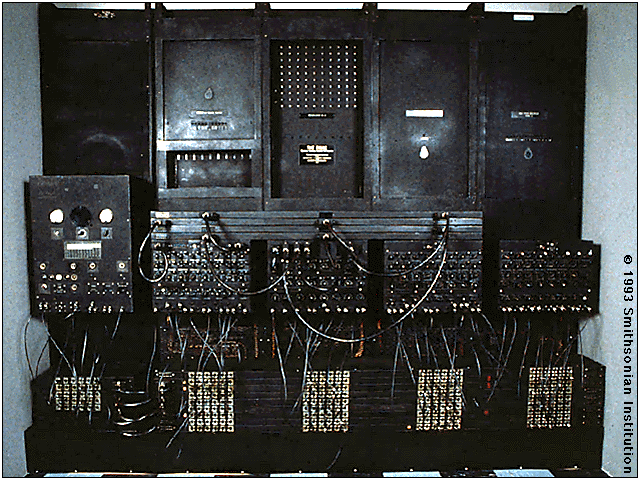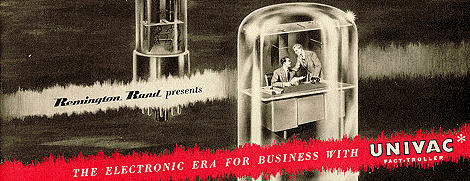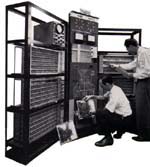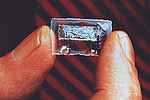A Digital Timeline
A History of Digital Technology
1901
to 1959
Compiled by Skip Schiel
(added
April 24, 2002)
(revised March 1, 2019)
An attempt at charting the trajectory of digital technology, with special attention to graphical applications. Comments solicited, corrections gladly considered, links and images most graciously desired. (Special note: those attributed as inventors or creators more often were joined by many others, some named, some not. And dates are often only approximations.)
1927
Sound cinema
Thomas Edison
"Edison invented the motion pictures as a supplement to his phonograph, in the belief that sound plus a moving picture would provide better entertainment than sound alone. But in a short time the movies proved to be good enough entertainment without sound. It has been said that although the motion picture and the phonograph were intended to be partners, they grew up separately. And it might be added that the motion picture held the phonograph in such low esteem that for years it would not speak. Throughout the long history of efforts to add sound, the success of the silent movie was the great obstacle to commercialization of talking pictures."
—Edward W. Kellog ,June 1955, Journal of the SMPTE
1936
The Turing Machine
Alan Turing
Could
there exist, at least in principle, a definite method or process by which
it could be decided whether any given mathematical assertion was provable?
To answer such a question needed a definition of 'method' which would
be not only precise but compelling. This is what Turing supplied. He analysed
what could be achieved by a person performing a methodical process, and
seizing on the idea of something done 'mechanically', expressed the analysis
in terms of a theoretical machine able to perform certain precisely defined
elementary operations on symbols on paper tape. He presented convincing
arguments that the scope of such a machine was sufficient to encompass
everything that would count as a 'definite method.' Daringly he included
an argument based on the transitions between 'states of mind' of a human
being performing a mental process.
— Andrew Hodges
1937
Digital computer
John Vincent Atanasoff & Clifford Berry at Iowa State University
The Atanasoff-Berry Computer was the world's first electronic digital computer. It was built by John Vincent Atanasoff and Clifford Berry at Iowa State University during 1937-42. It incorporated several major innovations in computing including the use of binary arithmetic, regenerative memory, parallel processing, and separation of memory and computing functions.
—Department
of Computer Science,
Iowa State University
1940
Breaking a German code, the Enigma
Alan Turing
Enigma M3
Enigma
is used to scramble all of Germany's most top-secret communications. It
is the most advanced cipher ever designed and was, until now, thought
unbreakable.
In 1938 Turing published a mathematical paper entitled On Computational
Numbers in which he introduced the theory of so-called Universal Turing
Machines, mechanical devices capable of being configured in order to tackle
any mathematical problem imaginable. Turing used this ingenious concept
to create precisely configurable large machines called "bombes"
capable of applying the enormous amount of mathematical effort required
to break the enigma code by brute force.
1941
Television
Television came into being based on the inventions and discoveries of many men and scientists. The 'first' generation of television sets were not entirely electronic. The display (TV screen) had a small motor with a spinning disc and a neon lamp, which worked together to give a blurry reddish-orange picture about half the size of a business card!
—www.tvhistory.tv/pre-1935.htm
1941
Digital computer (Z3)
Konrad Zuse
Konrad Zuse was the creator of the first full automatic, program controlled and freely programmable, in binary floating point arithmetic working computer. The Z3 was finished in 1941.
—Professor Dr. Friedrich L. Bauer
1943
Entirely electric computer (COLOSSUS)
Max Newman & Tommy Flowers
Colossus reduced the time to break Lorenz messages from weeks to hours. It was just in time for the deciphering of messages which gave vital information to Eisenhower and Montgomery prior to D-Day. These deciphered Lorenz messages showed that Hitler had swallowed the deception campaigns, the phantom army in the South of England, the phantom convoys moving east along the channel; that Hitler was convinced that the attacks were coming across the Pas de Calais and that he was keeping Panzer divisions in Belgium. After D-day the French resistance and the British and American Air Forces bombed and strafed all the telephone and teleprinter land lines in Northern France, forced the Germans to use radio communications and suddenly the volume of intercepted messages went up enormously.
—Tony Sale
Stored program, sort and merge operations
John Louis von Neumann
Von Neumann's interest in computers differed from that of his peers by his quickly perceiving the application of computers to applied mathematics for specific problems, rather than their mere application to the development of tables. During the war, von Neumann's expertise in hydrodynamics, ballistics, meteorology, game theory, and statistics, was put to good use in several projects. This work led him to consider the use of mechanical devices for computation, and although the stories about von Neumann imply that his first computer encounter was with the ENIAC, in fact it was with Howard Aiken's Harvard Mark I (ASCC) calculator.
—J. A. N. Lee
1944
Relay-based computer (MARK 1)
Howard Aiken at Harvard-IBM
The Mark I was constructed out of switches, relays, rotating shafts, and clutches, and was described as sounding like a "roomful of ladies knitting." The machine contained more than 750,000 components, was 50 feet long, 8 feet tall, and weighed approximately 5 tons!
—Bebop
BYTES Back
(An Unconventional Guide to Computers)
1946
ENIAC (electronic numerical integrator and computer)
John W. Mauchly and J. P. Eckert, Jr. at University of Pennsylvania
The world's first electronic digital computer was developed by Army Ordnance to compute World War II ballistic firing tables.
By
today's standards for electronic computers the ENIAC was a grotesque monster.
Its thirty separate units, plus power supply and forced-air cooling, weighed
over thirty tons. Its 19,000 vacuum tubes, 1,500 relays, and hundreds
of thousands of resistors, capacitors, and inductors consumed almost 200
kilowatts of electrical power.
But ENIAC was the prototype from which most other modern computers evolved.
It embodied almost all the components and concepts of today's high- speed,
electronic digital computers. Its designers conceived what has now become
standard circuitry such as the gate (logical "and" element),
buffer (logical "or" element) and used a modified Eccles-Jordan
flip-flop as a logical, high-speed storage-and-control device. The machine's
counters and accumulators, with more sophisticated innovations, were made
up of combinations of these basic elements.
—Martin H. Weik
1948
Transistor
Barden, Shockley, & Brattain
William Shockley and Walter Brattain had both been working with semiconductors since the early 1930’s, and in 1939, Shockley had an idea, to use a piece of copper screen in a piece of semi-conducting material. Although that particular experiment failed, in 1940 Russell Ohl accidentally discovers the silicon p-n junction at Bell Labs.
—Shelley A. Steiner
1951
Business computer (UNIVAC 1)
John W. Mauchly and J. P. Eckert, Jr. at University of Pennsylvania
The first UNIVAC computer was delivered to the Census Bureau in June 1951. Unlike the ENIAC, the UNIVAC processed each digit serially. But its much higher design speed permitted it to add two ten-digit numbers at a rate of almost 100,000 additions per second. Internally, the UNIVAC operated at a clock frequency of 2.25 MHz, which was no mean feat for vacuum tube circuits. The UNIVAC also employed mercury delay-line memories. Delay lines did not allow the computer to access immediately any item data held in its memory, but given the reliability problems of the alternative Cathode Ray Tube (CRT) technology, this was a good technical choice.
—University of Pennsylvania Library
1953
Transistorized computer
Tom Watson at IBM
Tom Watson, Jr., led IBM to introduce the model 604 computer, its first with transistors, that became the basis of the model 608 of 1957, the first solid-state computer for the commercial market. Transistors were expensive at first, cost $8 vs. $.75 for a vacuum tube.
—Steven E. Schoenherr
TRADIC—a fully transistorized computer
Bell Labs
TRADIC stands for TRAnisitor DIgital Computer, and as the name suggests this was the first machine to use all transistors and diodes and no vacuum tubes. It was built by Bell Labs for the U.S. Air Force, which was interested in the lightweight nature of such a computer for airborne use. The machine consisted of 700 point-contact transistors and 10,000 germanium diodes. During two years of continuous operation only 17 of these devices failed, a vastly lower failure rate than Vacuum tube machines of the time.
— Tom Howe
Integrated circuit
Jack Kilby at Texas Instruments
It was a relatively simple device that Jack Kilby showed to a handful
of co-workers gathered in TI's semiconductor lab more than 40 years ago
-- only a transistor and other components on a slice of germanium. Little
did this group of onlookers know, but Kilby's invention, 7/16-by-1/16-inches
in size and called an integrated circuit, was about to revolutionize the
electronics industry.
—Texas Instruments
Modem
Bell Labs
| General references |
Computer Technology Timeline by The Bookmark Chronology of Personal Computers A Chronology of Computer History Computing History, Myths and Legends (Ian Darwin) A Brief History of Computer Technology History of Communication From Cave Drawings
|
|
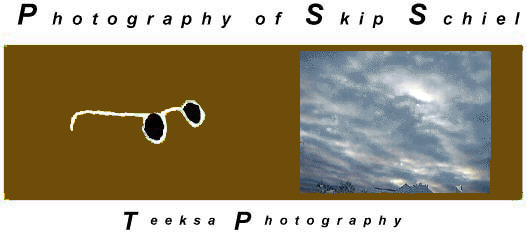 |
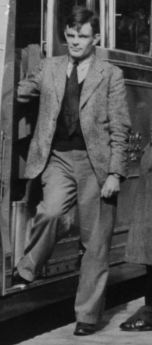
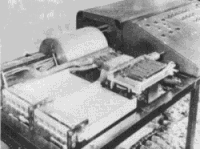
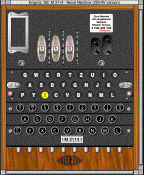
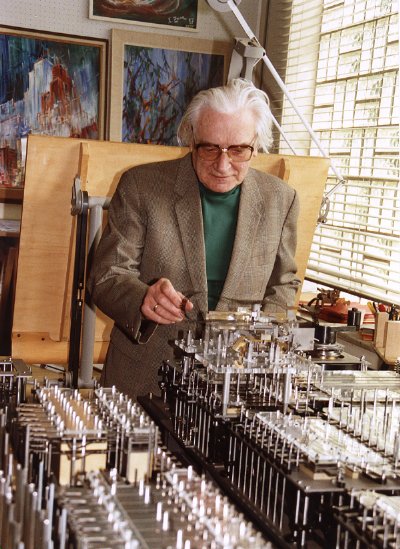
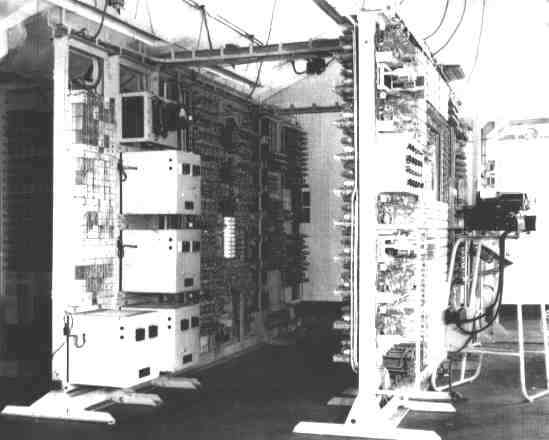
.gif)
